|
Dutch
Barn Preservation Society
Dedicated
to the Study and Preservation
of New World Dutch Barns
NEWSLETTER,
FALL 1991, Vol. 4, Issue 2 Part
Two
Bronck
Dutch barn, cross section of the fourth bent, looking north.
Drawing by Mark Peckham, July 1991.
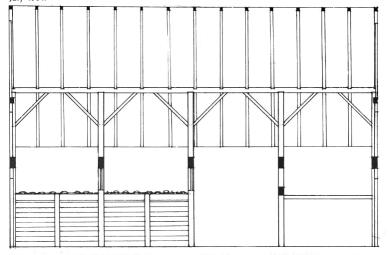
Bronck
Dutch barn, transverse section, looking west. Drawing by Mark
Peckham, July 1991.
The double anchor
beam at the rear of the barn, an early nineteenth century adaptation,
was integral to the construction of this barn and was not merely
added later. This adaptation occurred in the fourth bent of the
barn, where a second anchor beam was placed below the regular
anchor beam. The lower anchor beam was mortised into the columns
and also connected to the anchor beam above by mortised studs.
Along the top of the lower anchor beam were cut-outs to hold
joists reaching to the back wall; although these joists have
been removed, the cut ends remain in location on the back wall
and along the lower anchor beam. (See photo.) On these joists,
poles or a floor were laid for storing hay.
This fairly common nineteenth century modification of the traditional
Dutch barn plan provided additional hay storage space, but reduced
the size of the threshing floor and eliminated any possibility
of a rear door opposite the front door, so wagons could not pass
through. There is no evidence of a granary, a common feature in
Dutch barns. Neither is there any threshing pole pivot in the barn,
suggesting it was not used, as many barns were, for threshing by
a team of horses going around in a circle. In addition, since both
a rear door, for wind currents, and the threshing floor were essential
for winnowing, it appears that threshing or winnowing grain was
not a major activity planned for this barn when it was built. In
another related modification, the front wagon entrance was not
placed in the traditional center location. However, the floor,
with its two- and three-inch thick planks, was constructed in the
traditional way with a spline down the center. The spline, a part
of the frame under the barn, had a wide shoulder to support the
floorboards.
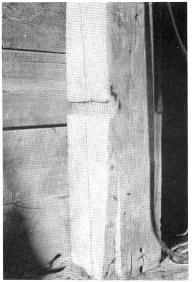 The
first three columns on the west side of the threshing floor were
modified -to carry supports for a manger, now gone. Column shown
is part of the third bent. The manger extended to the left. Photo
by Harold Zoch, June 1991. The
first three columns on the west side of the threshing floor were
modified -to carry supports for a manger, now gone. Column shown
is part of the third bent. The manger extended to the left. Photo
by Harold Zoch, June 1991.
It is most likely that not many horses were kept in this barn.
Facing in towards the threshing floor, the horses would have been
situated in that part of the west aisle in front of which the manger
was formerly located. Mortises and wear marks for the manger occur
in the first three columns on the west side of the threshing floor.
The manger extended for only the two bays closest to the south
end, rather than along one entire. side of the threshing floor,
as is sometimes the case. It has been theorized that the wagon
entrance was off center because the manger on the west side projected
into the threshing floor. Another possibility is the off-center
entrance may have been related to the absence of a rear exit and
to the extra hay storage at the rear.
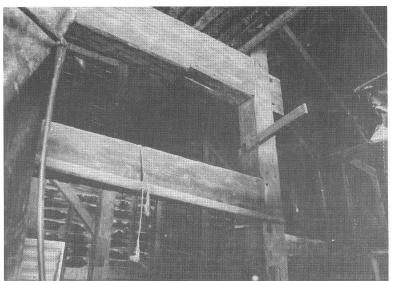
Extra, lower anchor beam in the fourth bent was
integral to the Bronck barn's frame construction. It was intended
to support a floor for an extra hay loft. Photo by Harold Zoch,
June 1991.
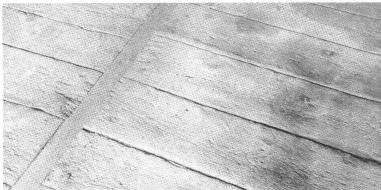
Thick boards of the threshing floor met at a center
spline, where they were held in place by pegs. Photo by Harold
Zoch, June 1991.
Since hay storage seemed uppermost in the minds of the builders
of the Bronck Dutch barn, a construction date in the first third
of the nineteenth century, when dairying was more important than
grain production, is plausible. It seems in character that the
Broncks retained the Dutch framing style because they had a good
anchor beam set available from another barn, and because of their
strong Hudson Valley heritage.
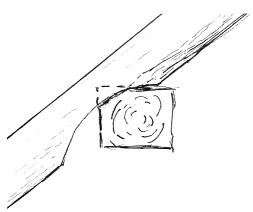 Roof
rafter has curved notch over purlin. Roof
rafter has curved notch over purlin.
Members Shirley Dunn, Mark Hesler, Greg Huber,
Peter Sinclair, and Harold Zoch, and Greene County Historical
Society members Raymond Beecher and Shelby Kriele have contributed
to the text of the preceding article. Other Dutch Barn Preservation
Society members have helped measure and analyze the barn.
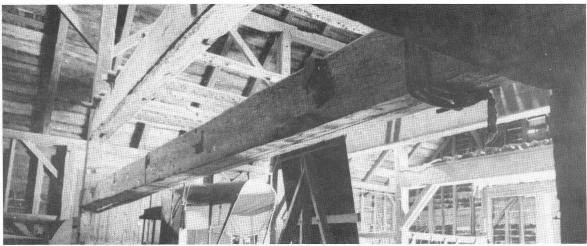
View of double anchor beam from the rear. Note
the cut off ends of the hay loft floor joists in the lower anchor
beam, center of picture. Photo by Peter Sinclair, June 1991.
RESEARCH FINDS: Hay
Barracks
SOCIETY Activities:
|